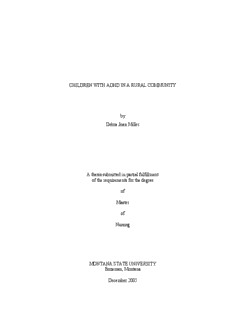
CHILDREN WITH ADHD IN A RURAL COMMUNITY by Debra Joan Miller A thesis submitted in ... PDF
Preview CHILDREN WITH ADHD IN A RURAL COMMUNITY by Debra Joan Miller A thesis submitted in ...
CHILDREN WITH ADHD IN A RURAL COMMUNITY by Debra Joan Miller A thesis submitted in partial fulfillment of the requirements for the degree of Master of Nursing MONTANA STATE UNIVERSITY Bozeman, Montana December 2005 © COPYRIGHT by Debra Joan Miller 2005 All Rights Reserved ii APPROVAL of a thesis submitted by Debra Joan Miller This thesis has been read by each member of the thesis committee and has been found to be satisfactory regarding content, English usage, format, citations, bibliographic style, and consistency, and is ready for submission to the College of Graduate Studies. Karen Zulkowski, DNS, RN, CWS Committee Chair Approved for the College of Nursing Elizabeth Nichols, DNS, RN, FAAN Dean Approved for the College of Graduate Studies Joseph J. Fedock, PhD Graduate Dean iii STATEMENT OF PERMISSION TO USE In presenting this thesis in partial fulfillment of the requirements for a master’s degree at Montana State University, I agree that the Library shall make it available to borrowers under the rules of the Library. If I have indicated my intention to copyright this thesis by including a copyright notice page, copying is allowable only for scholarly purposes, consistent with “fair use” as prescribed in the U.S. Copyright Law. Requests for permission for extended quotation from or reproduction of this thesis in whole or in parts may be granted only by the copyright holder. Debra Joan Miller December 2005 iv Dedicated to ROBERT LELAND, M.D. v TABLE OF CONTENTS 1. INTRODUCTION..........................................................................................................1 Problem...........................................................................................................................2 Purpose............................................................................................................................3 Objectives.................................................................................................................3 Theoretical Framework...................................................................................................3 Concept Definitions........................................................................................................6 ADHD........................................................................................................................6 ADHD Subtypes.............................................................................................6 Comorbidity..............................................................................................................7 Learning Disabilities.......................................................................................7 Risk Factors....................................................................................................7 Rural..........................................................................................................................8 Child/Children...........................................................................................................8 Assumptions....................................................................................................................8 2. REVIEW OF LITERATURE.......................................................................................10 Diagnosis.......................................................................................................................10 Validity of the ADHD Syndrome...........................................................................10 Prevalence of ADHD..............................................................................................12 Comorbidity in ADHD...........................................................................................14 Etiology of ADHD..................................................................................................17 Intervention/Treatment.................................................................................................21 Outcomes/Burden of ADHD.........................................................................................24 Effects on the Individual..........................................................................................24 Effects on the Family...............................................................................................30 Costs to Individuals, Families, and Society.............................................................33 3. METHODS...................................................................................................................37 Design...........................................................................................................................37 Population/Sample........................................................................................................39 IRB Exemption.......................................................................................................40 Procedure for Data Collection......................................................................................41 Instrumentation.............................................................................................................41 Analysis.........................................................................................................................44 4. RESULTS.....................................................................................................................46 Description of Sociodemographic Attributes................................................................46 Distribution of ADHD Subtypes and Age at Time of Diagnosis..................................48 Comorbidity in Rural Children with ADHD................................................................49 Comorbid Psychological Conditions......................................................................49 Comorbid Medical Conditions................................................................................50 vi TABLE OF CONTENTS-CONTINUED 4. RESULTS (continued)..................................................................................................46 Comorbid Learning Disabilities..............................................................................51 Specific Learning Disabilities.......................................................................54 Other Special Education Categories.............................................................54 Relationships among Attributes, ADHD Subtypes, and Comorbid Conditions...........55 5. DISCUSSION...............................................................................................................60 Summary of Results......................................................................................................61 Implications for Clinical Practice.................................................................................64 Recommendations for Future Research........................................................................66 Limitations....................................................................................................................67 Theoretical Limitations...........................................................................................67 Methodologicial Limitations...................................................................................68 Limitation of Instruments........................................................................................69 Conclusion....................................................................................................................71 REFERENCES..................................................................................................................72 APPENDICES...................................................................................................................86 APPENDIX A: Attention Deficit/Hyperactivity Disorder*Symptoms of ADHD......88 APPENDIX B: Publication of the National Dissemination Center for Children with Disabilities…………………………………………………….90 APPENDIX C: Case Report Form-Demographic & Diagnostic Information.............97 APPENDIX D: Request for Designation of Research as Exempt from the Requirement of IRB Review………………………………………..99 APPENDIX E: Institutional Review Board………………………………………...104 vii LIST OF TABLES Table Page 1. Sociodemographic Attributes of Rural Children with ADHD………………………………………………………………47 2. Gender & ADHD Diagnostic Subtypes in Rural Children………………...............48 3. Frequency of Comorbid Psychological Conditions in Rural Children with ADHD…………………………………………...50 4. Frequency of Medical Conditions Co-existing with with ADHD in Rural Children…………………………………………...51 5. Frequency of the Range of IQ Scores Identified in Rural Children with ADHD…………………………………………...53 6. Frequency of Specific Learning Disabilities Associated with ADHD in Rural Children…………………………………………...54 7. Frequency of Other Special Education Disabilities Associated with ADHD in Rural Children………………………………55 8. Relationships Among Variables…………………………………………………...58 viii LIST OF FIGURES Figure Page 1. Levine’s Conservation Model-Nursing Process in the Community………………………………………………………………4 2. Asymmetry of Distribution for Ethnicity in Rural Children with ADHD……………………………………………………………..46 ix ABSTRACT Children with ADHD experience a myriad of chronic behavioral and academic difficulties. If attributes among rural children are similar to those described by studies conducted on the urban population, educators and health care professionals may have grossly underestimated the public health impact of ADHD Research does not provide adequate descriptive data of children with ADHD in rural communities and until more is known about actual attributes of these children, there will continue to be disparities in identification, access to treatment, and reports of the manifestations of ADHD and its co-existing conditions. Levine’s Conservation Model- Nursing Process in the Community provides the theoretical framework for the study. A Descriptive Correlational study is conducted to gain information on the demographic attributes; to identify the distribution of ADHD subtypes; and to explore the comorbidity associated with ADHD in rural children. The sample consists of 88 children seen at a pediatric outreach clinic located in a rural community in southern Wyoming. Secondary data analysis makes the study exempt from IRB review. Descriptive statistics are used to organize and analyze the data. Because of the small sample size, results may only indicate potential trends. Findings may not be statistically significant but clinically they assisted the community in proposing systems for establishing family-centered, community-based care. The gender ratio is similar to those of larger studies with more boys than girls diagnosed. This raises the continued concern that ADHD may be under-diagnosed in girls in rural communities. Caucasians are diagnosed more frequently, raising the concern that minorities are under-diagnosed or underrepresented in research. Findings on the distribution of subtypes is somewhat ambiguous when compared to other studies. Most of the children were diagnosed during school transition times (1st and 3rd grades). Psychological comorbidities were diagnosed in 27.3% and 55.7% were identified with learning disabilities. Sleep disturbances were frequently associated with the diagnosis of ADHD and depression was found to contribute substantially to sleep disturbances. ADHD can be characterized by heterogeneity and ambiguity, and confounded by comorbidity. Nurse Practitioner strategies should include: collaborative assessment; case planning; advocacy; management; and building systems to provide a multimodal approach to interventions.
Description: